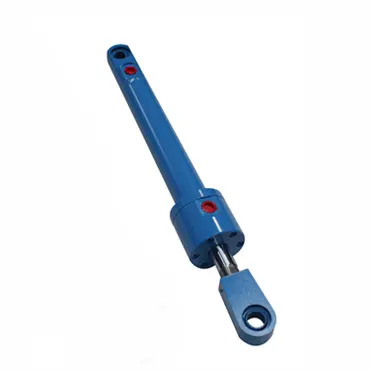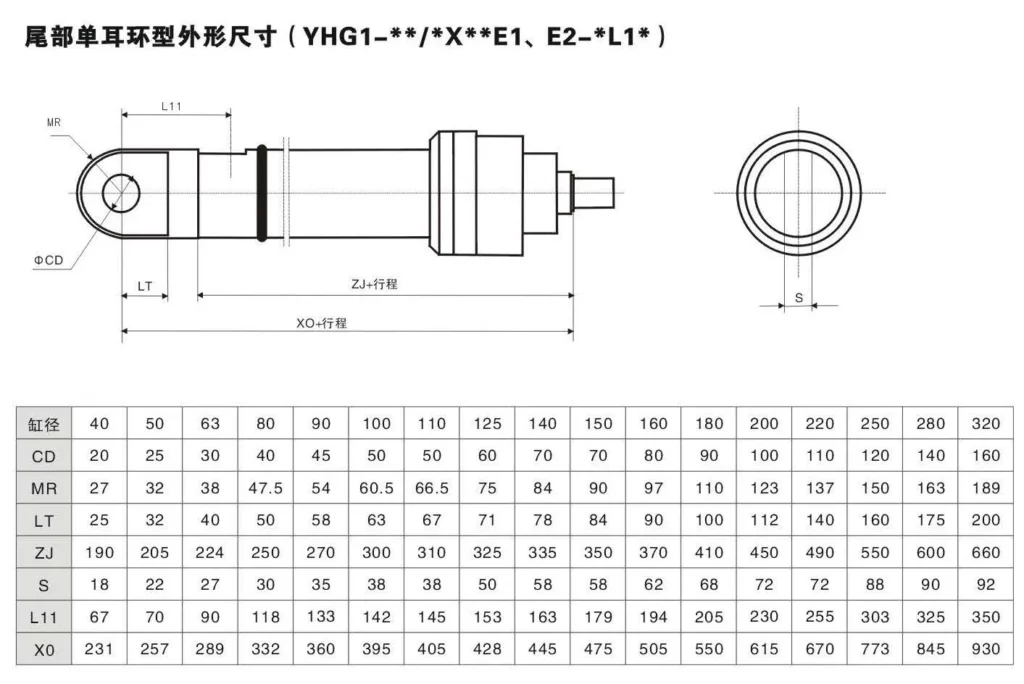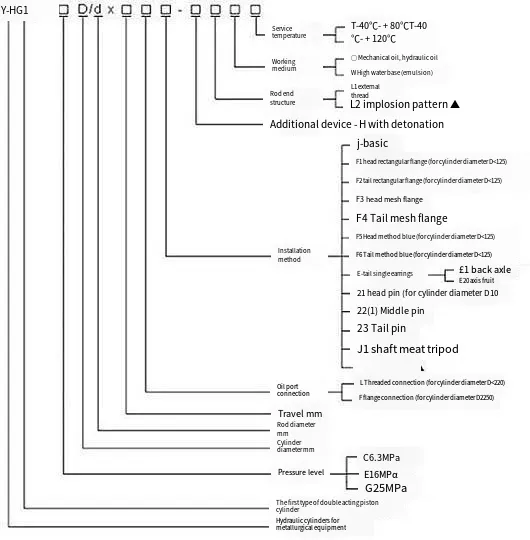Y-HG1 Metallurgical Hydraulic Cylinder
Jako jeden z producentów, dostawców i eksporterów produktów mechanicznych, oferujemy cylindry hydrauliczne i wiele innych produktów.
Prosimy o kontakt w celu uzyskania szczegółowych informacji.
Poczta:sales@hydraulic-cylinders.net
Producent dostawca eksporter siłowników hydraulicznych.
Y-HG1 Metallurgical Hydraulic Cylinder
Y-HG1 series metallurgical equipment hydraulic cylinder is a double-acting piston cylinder, and the cylinder diameter is generally in the range of 40~320mm, the working pressure <=16MPA, the hydraulic oil mechanical system can be used for milk transport and other working medium, installation flange, earrings, pins, release device (base) and different types.
High precision CNC honing machine, automatic welding machine, vertical, horizontal machining center, gantry machining center, CNC lathe, and other processing equipment, product quality is stable and guaranteed.

Metallurgical Hydraulic Cylinder Parameter:
(1)Axial Tripod Type Metallurgical Hydraulic Cylinder Parameter
(2)Head Method Orchid Type Metallurgical Hydraulic Cylinder
(3)Head Pin Type Metallurgical Hydraulic Cylinder
(4)Head Rectangular Flange Type Metallurgical Hydraulic Cylinder
(5)Head Round Flange Type Metallurgical Hydraulic Cylinder
(6) Middle Pin Type Metallurgical Hydraulic Cylinder
(7)Rear Method Orchid Type Metallurgical Hydraulic Cylinder
(8)Rear Pin Type Metallurgical Hydraulic Cylinder
(9)Rear Rectangular Flange Type Metallurgical Hydraulic Cylinder
(10)Rear Round Flange Type Metallurgical Hydraulic Cylinder

(11)Rear Single Earring Type Metallurgical Hydraulic Cylinder

(12) Y-HG1 Noraml Metallurgical Hydraulic Cylinder
Metallurgical Hydraulic Cylinder Technical Parameter:
Model example: Y-HG1-E40/22*50LJ1L10T1

Metalurgiczny siłownik hydrauliczny Scope Of Application:
The hydraulic cylinder of Y-HG1 series metallurgical equipment is a double-acting piston cylinder. The cylinder diameter is generally in the range of 40~320mm, and the working pressure <=16MPA; its basic parameters include cylinder diameter, rod diameter, stroke, oil port size, and so on.
How To Take Apart A Hydraulic Cylinder?
Taking apart a hydraulic cylinder requires careful disassembly to avoid damage and ensure safe handling. Here are the general steps to follow:
- Safety Precautions:
- Ensure the hydraulic system is depressurized and the cylinder is in a retracted position.
- Use appropriate personal protective equipment, such as gloves and safety glasses.
- Prepare a clean and organized workspace with adequate lighting and ventilation.
- Identify Cylinder Components:
- Familiarize yourself with the different parts of the hydraulic cylinder, including the cylinder body, piston, rod, seals, and end caps.
- Remove External Connections:
- Disconnect any hydraulic hoses, fittings, or other external connections attached to the cylinder.
- Use appropriate tools, such as wrenches or pliers, to loosen and remove the connections carefully.
- Secure the Cylinder:
- Place the cylinder securely in a vise or similar holding fixture, ensuring it is stable and won’t move during disassembly.
- Remove the Rod End Cap:
- Locate the rod end cap, which is typically situated at the end of the cylinder opposite the piston.
- Use the appropriate wrench or socket to loosen and remove the bolts securing the rod end cap.
- Tap the end cap gently with a rubber mallet if needed to break any seal or adhesive bond.
- Separate the Rod and Piston Assembly:
- Once the rod end cap is removed, carefully slide the rod and piston assembly out of the cylinder body.
- Support the weight of the assembly to prevent it from falling or causing damage.
- Disassemble the Rod and Piston Assembly:
- Examine the rod and piston assembly for retaining rings, snap rings, or other retaining devices.
- Use appropriate tools, such as pliers or snap ring pliers, to remove these retaining devices, allowing the disassembly of the assembly into its individual components.
- Take note of the order and orientation of each component for reassembly.
- Inspect and Clean:
- Inspect all the disassembled components for wear, damage, or signs of leakage.
- Clean each component thoroughly using an appropriate solvent or cleaning agent to remove dirt, debris, and hydraulic fluid residue.
- Dry the components completely before reassembly.
- Reassembly or Component Replacement:
- If necessary, replace any damaged or worn components with new ones following the manufacturer’s specifications.
- Reassemble the hydraulic cylinder in the reverse order of disassembly, ensuring proper alignment and orientation of components.
- Tighten bolts or fasteners to the manufacturer’s recommended torque specifications.
Możliwości i pojemność fabryki:
(1) Montaż
Dysponujemy najwyższej klasy niezależną platformą badawczo-rozwojową. Warsztat produkcji siłowników hydraulicznych posiada cztery półautomatyczne linie montażowe siłowników podnoszących i jedną automatyczną linię montażową siłowników przechyłu, o projektowanej rocznej zdolności produkcyjnej 1 miliona sztuk. Specjalny warsztat cylindrów jest wyposażony w różne specyfikacje półautomatycznego systemu montażu czyszczącego o projektowanej rocznej zdolności produkcyjnej 200 000 i wyposażony w słynny sprzęt do obróbki CNC, centrum obróbcze, specjalny sprzęt do precyzyjnej obróbki cylindrów, robot spawalniczy, automatyczna maszyna czyszcząca, automatyczna maszyna do montażu cylindrów i automatyczna linia produkcyjna do malowania. Istniejący krytyczny sprzęt składa się z ponad 300 zestawów. Optymalna alokacja i efektywne wykorzystanie zasobów sprzętowych zapewniają wymagania dotyczące dokładności produktów i spełniają potrzeby wysokiej jakości produktów.


(2) Obróbka
Warsztat obróbki skrawaniem jest wyposażony w niestandardowe centrum tokarskie z pochyloną szyną, centrum obróbcze, szybkobieżną honownicę, robota spawalniczego i inny powiązany sprzęt, który może obsługiwać przetwarzanie rur cylindrycznych o maksymalnej średnicy wewnętrznej 400 mm i maksymalnej długości 6 metrów.

(3) Spawanie

(4) Malowanie i powlekanie
Z małymi i średnimi automatycznymi liniami do powlekania farbami na bazie wody, w celu osiągnięcia automatycznego załadunku i rozładunku robota oraz automatycznego natryskiwania, wydajność projektowa 4000 sztuk na zmianę;
Posiadamy również półautomatyczną linię do produkcji farb do dużych cylindrów napędzaną łańcuchem napędowym, o wydajności 60 skrzyń na zmianę.


(5) Testowanie
Dysponujemy najwyższej klasy urządzeniami kontrolnymi i stanowiskami testowymi, aby zapewnić, że wydajność cylindra spełnia wymagania.

Jesteśmy jednym z najlepszych producentów metalurgicznych siłowników hydraulicznych. Możemy zaoferować kompleksowe zapasy metalurgicznych siłowników hydraulicznych. Zapewniamy również odpowiednie przekładnie rolnicze. Eksportowaliśmy nasze produkty do klientów na całym świecie i zdobyliśmy dobrą reputację dzięki najwyższej jakości produktów i usług posprzedażnych. Zapraszamy klientów w kraju i za granicą do kontaktu z nami w celu negocjacji biznesowych, wymiany informacji i współpracować z nami!
Zapraszamy na wycieczkę po naszej fabryce VR:
Wybierz się na wycieczkę po naszej fabryce VR z następującymi elementami
Jak działa siłownik hydrauliczny wózka widłowego?
Siłownik hydrauliczny Zastosowanie:













